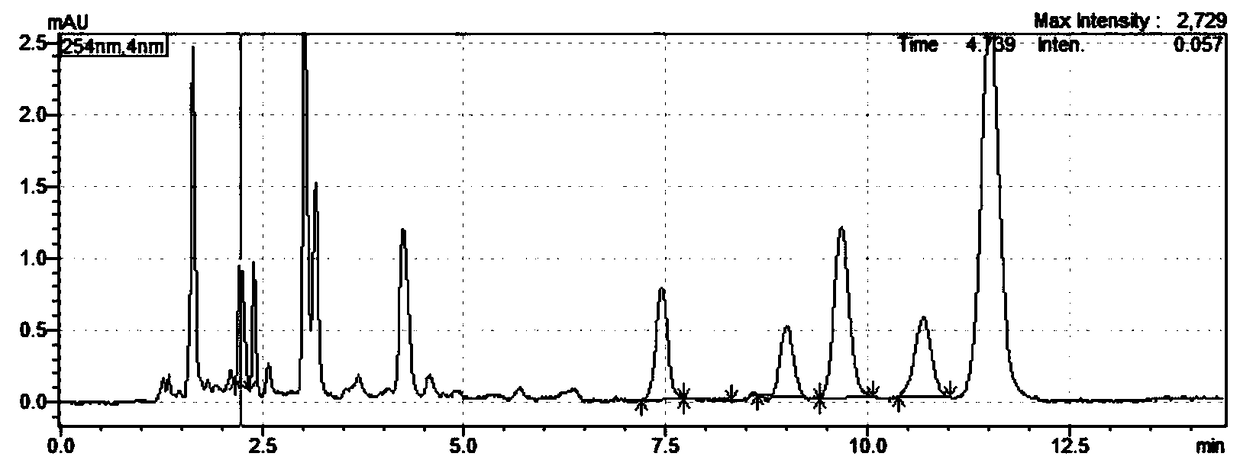A high-performance liquid chromatography detection method for nucleotides in food
A high-performance liquid chromatography and nucleotide technology, applied in the field of food detection, can solve the problems of expensive instruments, large matrix interference, poor reproducibility of measurement results, etc., and achieve the effect of wide application range and good linear relationship.
- Summary
- Abstract
- Description
- Claims
- Application Information
AI Technical Summary
Problems solved by technology
Method used
Image
Examples
Embodiment 1
[0068] Embodiment 1 detection method
[0069] 1. Sample pretreatment
[0070] Weigh 0.5g of the sample into a 50mL polytetrafluoroethylene centrifuge tube, add 10mL of aqueous solution, adjust the pH between 4 and 5 with glacial acetic acid, vortex for 5 minutes, add 40mL of ethanol solution, and centrifuge at 10000r / min after vortexing for 5min Wash with ethanol solution for 10 minutes, spin dry at 60°C, dilute to volume with 5-10mL water, take 1mL and pass through a 0.22μm filter membrane in a sample bottle for analysis on the machine.
[0071] 2. Perform high performance liquid chromatography detection
[0072] (1) Chromatographic column: SB-AQ column.
[0073] (2) Mobile phase: tetrabutylammonium bisulfate.
[0074] (3) The detection wavelength of liquid chromatography is 254nm.
[0075] (4) The column temperature is between 60 and 70°C.
[0076] (5) The time for the sample to be put on the machine is 60 to 240 hours after the sample is prepared, and the sample needs ...
Embodiment 2
[0078] The selection and optimization of the sample pretreatment method of embodiment 2
[0079] The selection and optimization of the influencing factors of specific pretreatment methods are as follows:
[0080] 1. Selection of Precipitating Acid
[0081] Comparing different acids as protein precipitating agents, it is found that after different acids are precipitated, the impurities that appear are not the same (as attached Figures 11 to 14 shown). Oxalic acid has strong interference at the peak position of CMP, followed by hydrochloric acid. The peak time of formic acid and acetic acid impurities is basically the same, but formic acid has more impurities near CMP. It shows that it is better to use acetic acid as precipitant.
[0082] 2. The influence of ethanol and acetic acid (acetic acid) coprecipitation
[0083] as attached figure 1 and 2 As shown, comparing the direct application of acetic acid precipitation to constant volume and the co-precipitation of acetic a...
Embodiment 3
[0088] The optimization of embodiment 3 assay conditions
[0089] 1. Selection of chromatographic column: After comparing SB-AQ, TC, XDB, T3, amide and other C18 chromatographic columns, it was found that SB-AQ has better separation and stability of nucleotides, so SB-AQ column was selected for Determination.
[0090] 2. Selection of mobile phase
[0091] Adding the ion-pair reagent tetrabutylammonium bisulfate to the mobile phase can better separate the five nucleotides and impurities. The effect of different concentrations of ion-pairing reagents on the retention time of UMP, AMP and IMP is within ±2min, while the effect on the retention time of CMP and AMP is within ±1min, so it can be effective by adjusting the ion-pairing reagent concentration or other conditions. Separation of five nucleotides as well as impurities. When the concentration of tetrabutylammonium bisulfate was 0.6g / L, the resolution of 5 kinds of nucleotides was the best, and the resolution of IMP and th...
PUM
| Property | Measurement | Unit |
|---|---|---|
| wavelength | aaaaa | aaaaa |
| correlation coefficient | aaaaa | aaaaa |
| recovery rate | aaaaa | aaaaa |
Abstract
Description
Claims
Application Information
 Login to View More
Login to View More - R&D Engineer
- R&D Manager
- IP Professional
- Industry Leading Data Capabilities
- Powerful AI technology
- Patent DNA Extraction
Browse by: Latest US Patents, China's latest patents, Technical Efficacy Thesaurus, Application Domain, Technology Topic, Popular Technical Reports.
© 2024 PatSnap. All rights reserved.Legal|Privacy policy|Modern Slavery Act Transparency Statement|Sitemap|About US| Contact US: help@patsnap.com










